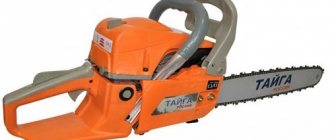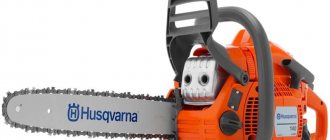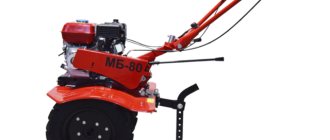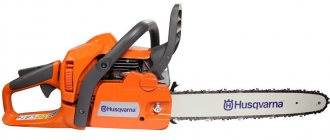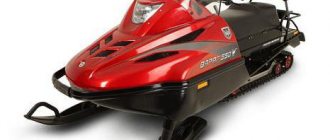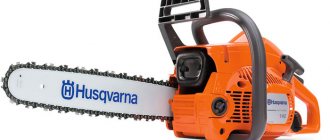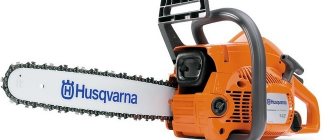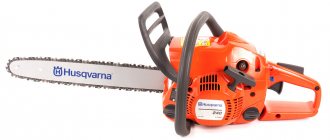The creators of the semi-professional chainsaw Taiga 245 tried to simplify its design as much as possible, with minimal use of plastic. The result is a fairly reliable and maintainable unit. However, the significant weight of the saw (8.95 kg) does not make it possible to use it for professional purposes, but for household needs this tool is quite suitable. A chainsaw can be used for harvesting and sawing firewood, during the repair and construction of residential buildings, sheds, gazebos, bathhouses, and other utility rooms.
- Capacious fuel tank (800 ml.);
- High maintainability;
- The body and most parts of the chainsaw are made of metal;
- Effective automatic lubrication system for the saw set;
- Russian-language manual.
Chainsaw Taiga 245
Chainsaw Taiga 245
- Taiga 245 chainsaw device
- Carburetor Taiga 245
- Technical characteristics of the Taiga 245 chainsaw
- Reviews of chainsaw Taiga 245
Chainsaw Taiga 245 – a long-known and well-proven tool. This is a reliable high-power device used in forestry and for domestic needs. Thanks to these factors, the saw, despite its obsolescence, still remains relevant and in demand among consumers, as well as spare parts and consumables for it.
Owner reviews
Mikhail, Almaty:
“If you buy a chainsaw from a domestic manufacturer, then not the Taiga 245. I bought it for my dacha 3 years ago. At that time there were already better models, but I took the cheaper ones. It worked well for two years, but is hard to tinker with. The carburetor keeps breaking down. The only parts I replaced were the spark plug. You can easily sharpen the chain yourself. Among the main disadvantages is the heavy weight.”
Taras, Sevastopol:
“Four years ago I bought a Taiga 245 for work (I work at a sawmill), but I only used it for six months. Now I use it to cut down old trees at my dacha. It is difficult to use at home, as it is heavy. It is difficult to find parts on the market - the model is outdated. Pros: cheap. Cons: heavy, poor components.”
Description
Taiga chainsaws are rarely used in industry due to their technical characteristics and weight. Taiga 245 is a powerful tool that was designed for deforestation and work in suburban areas. Due to its heavy weight (9 kg), this model has not found wide application in industry.
The chainsaw is powered by a 2.6 kW two-stroke petrol engine. The length of the tire is 40 cm. In comparison with modern foreign and domestic models, Taiga 245 is an outdated model.
Advantages of the Taiga 245 chainsaw:
- resistance to falls and damage. The device body is made of high-strength, impact-resistant plastic.
- ease of repair and maintenance. The operating instructions contain a diagram of how the chainsaw works and a brief troubleshooting guide. Availability of parts and ease of replacement reduces the need to contact a service center.
- low cost.
The note! With prolonged use, the chainsaw loses power, breaks down and stops starting. The manufacturer recommends using the tool for no more than 40 minutes.
When working with a chainsaw, special attention should be paid to the carburetor. On some models, the manufacturer installed a Japanese carburetor from Walbro.
Due to temperature changes, this structural part often fails and the carburetor has to be adjusted frequently. Country of origin: Russia.
Carburetor
The carburetor of the Taiga 245 chainsaw deserves special attention, because... Most of the malfunctions are caused by it. Taiga 245 is equipped with a floatless membrane-type carburetor KMP-100US, with a built-in pump. The pump supplies fuel from the tank to the carburetor.
Main structural elements of a carburetor:
- pressure regulator;
- air damper;
- throttle valve;
- mixture adjustment screws;
- fuel pump.
Some Taiga 245 chainsaws were equipped with Japanese Walbro carburetors. There is no data on them.
There is no need to adjust the carburetor for no reason, because... It comes from the factory with optimal adjustments. Additional adjustment of the carburetor may be required if there is a sudden change in temperature, or after disassembling the carburetor itself. It should be carried out strictly according to the instructions using 3 screws responsible for adjusting the supply of the fuel-air mixture.
Device
Taiga 245 is a modern chainsaw, made in a plastic case made of impact-resistant material. Not afraid of falls, impacts of medium strength, because... the main part of the elements is made of metal. It is worth noting its heavy weight - 8.95 kg not including fuel. Similar saws weigh significantly less.
Saw dimensions: 900 x 280 x 300. Supplied complete with a saw set based on a 40 cm bar and a chain with a pitch of 9.3 mm.
The Taiga chainsaw is based on a 2-stroke gasoline engine with a power of 2.6 kW, which is achieved when the crankshaft rotates at 7000 rpm. The working volume is 75 cubic centimeters. The piston group cylinder is not hardened, this reduces the service life of the chain saw. This criterion is important for large volumes of work, where the saw operates under load for a long time, almost without stopping. In everyday use, it is not critical whether the piston is hardened or not. The piston size is 50 mm in diameter. The manufacturer recommends using the chainsaw for no more than 40 minutes; after this time, the tool should rest.
The chainsaw is safe for the environment when used with special-purpose oils.
Taiga 245 uses universal motor oil for both the chain and the engine. It is diluted in a ratio of 1 to 20. Yes, yes, exactly 1/20 is a distinctive feature of the Taiga 245 saw. The brand of gasoline is AI-92. As noted above, the same oil is used to lubricate the chain as is used in the engine. In summer, the oil should be diluted with gasoline in a ratio of 1/4. According to reviews from many saw owners, used oil (waste oil), for example from a car engine, can be used to lubricate the chain.
DIY repair
The Taiga 245 chainsaw does not last forever and tends to break, like any other equipment. The design of the saw is simple and allows you to repair it with your own hands, almost on your knees, using a handy tool. Let's look at the main breakdowns.
Taiga 245 manual is the main chainsaw document that you should rely on during repairs. We strongly recommend that you study not only the description, but also the content.
Engine
Dvitagel is one of the weak points of the Taiga 245 chainsaw. Common problems:
- the engine does not start;
- the engine starts, but runs unstable and/or stalls;
- works unsteadily;
- does not develop full power.
Most of the listed malfunctions occur in the saw due to problems in the ignition system. As everyone knows, the main element of the ignition system is the spark plug, therefore, the first step is to carry out a visual inspection of it.
If you can see excess fuel mixture on the spark plugs, it means it has been “flooded”; you should wipe the spark plug, dry it, put it back and try to start again.
Assess the color of the carbon deposits on the spark plugs. If it is sand-colored, then the spark plug is working. For any other color: black, yellow, red, gray, it should be replaced.
If the chainsaw spark plug is dry, then there is a problem with the fuel supply to the combustion chamber; you should check the fuel supply system.
Fuel supply system
If a malfunction is detected in the fuel supply system (dry spark plug), the first thing you should check is:
- Check the fuel filter.
- Check the flow of fuel into the combustion chamber.
Dirty filter - replace. The recommended replacement interval is once every 3 months.
To check whether fuel is flowing or not, you need to remove the hose from the carburetor and see if the fuel flows or not. If fuel comes out of the hose, then the problem lies in the carburetor. If fuel does not flow, clean the hose.
Cylinder - piston group
Problems with the CPG are classified as serious and entail high repair costs. The main causes of CPG problems are a drop in power. You can identify problems with the piston by measuring the pressure with a compression gauge in the combustion chamber. To do this, remove the spark plug, insert the device in its place and try to start the saw and look at the device readings. If the instrument needle is in the red zone (8-9 atmospheres), then piston repair is 100% necessary.
Chain brake
The chainsaw chain is stopped by a special brake band; when it becomes clogged with dirt from sawdust and oil, problems with the brake appear. The housing should be removed and thoroughly cleaned of dirt.
Muffler
Over time, the muffler becomes clogged with combustion products from the spark arrester, which causes difficulty in removing exhaust gases. By creating excessive resistance in the exhaust tract, the chainsaw stops developing maximum speed. Also, the muffler becomes clogged due to excess oil in the fuel mixture.
To repair it yourself, you will need to dismantle the muffler, disassemble it and clean it thoroughly. You may have to resort to using detergents.
After dismantling the muffler, be sure to plug the exhaust hole with a rag to prevent foreign objects from getting inside the chainsaw.
Before installation, do not forget to dry the muffler with a hairdryer.
Specifications
Structurally, the Taiga 245 saw is made with a minimum of plastic parts, which negatively affects its weight category; the dry weight of the tool with the saw set is less than 9 kg.
- The drive of the 16-inch saw set is realized from a 2-stroke low-speed power unit with a power of 2.5 kW. The cylinder volume of 75 cm3 ensures stable engine traction characteristics and a sufficient supply of torque in all operating modes.
- The operational feature of the tool is that it works on a gasoline-oil mixture prepared in a ratio of 20:1.
- The oil, which lubricates and cools the parts of the saw set, the bar and the saw chain, is supplied to the cut by a pump with constant output. Its increased consumption is compensated by the low cost of domestic lubricants.
Maintainability
In particular, many potential buyers are attracted by the possibility of independent, affordable maintenance and major repairs. The independent solution of adjustment and repair problems is facilitated by a highly informative instruction manual and spare parts available in the range and price range.
Timely and complete DIY repairs can reduce operating costs by almost half and reduce the level of dependence on service and repair structures.
Advantages and disadvantages of the Taiga chain saw
Advantages:
- Durable engine made of quality materials;
- Manual pump for pumping fuel (primerik);
- Two-stage air purification system, easily accessible air filter;
- Fuel system from the Japanese company Walbro;
- Ergonomic body and rubberized handles;
- Multi-point anti-vibration system on metal springs;
- Instant chain stop brake with double initiation;
- The presence of a metal gear stop and protection against rebound;
- Blocking accidental activation.
Flaws:
- Low quality starter;
- Some models consume large amounts of fuel;
- There are complaints about the quality of the plastic;
- The Taiga chainsaw is equipped with a weak guide bar and chain.
Distinctive features
The main distinctive features of Taiga 245 include:
- The engine is two-stage.
- Easy to start a cold engine.
- Low fuel consumption.
- No oil leaks after long breaks in operation.
- You can use domestic oils in your work.
The Taiga 245 chainsaw can be repaired if problems arise. You can do it yourself if you have the appropriate experience. But it’s better to hand it over to a specialist so that he can do all the required work himself.
Determining the cause of the non-working condition of the Taiga-245 chainsaw.
Two days of fiddling with the chainsaw was enough to diagnose it, and the time for repair came in the evening of the second day. We have identified two reasons for the inoperability of the Taiga-245 chainsaw .
- 1. The segment key of the magneto flywheel is broken.
We were a little upset. We made a new one. The source of the material was an old support wheel pin from a ZAZIK.
- The workpiece was cut to the required size.
- Without effort, constantly cooling in water, they ground it on an emery stone.
- Adjusted to the required size.
- We polished it with a sharpening stone and installed the resulting key in its place.
How was the broken segment key determined? When trying to start the engine, we noticed a kickback, indicating early ignition timing. We also noticed rare flashes in the muffler or carburetor.
- 2. The volume of fuel in the working chamber of the carburetor does not correspond to the amount of fuel consumed by the engine in all modes.
The source of the cause was the spring of the rocker arm, which opens the fuel valve at the moment of discharge and the deformation of the lever of the rocker arm itself.
In our opinion, the constant compression of the spring during operation of the chainsaw led to its slight deformation, but sufficient to change the operation of the carburetor and thereby disrupt the operation of the chainsaw engine.
The rocker arm also turned out to be slightly bent and, when fully pressed by the diaphragm pusher, it could not fully open the fuel valve. The engine did not have enough fuel under load. But because of the soft spring, when trying to start the engine, there was so much fuel that the spark plug was flooded and, naturally, starting the engine was the most stressful and time-consuming process.
- We selected a new spring of the appropriate diameter and with a little more rigidity.
- We bent the rocker arm 1mm-1.5mm towards the pusher.
How was the change in the amount of fuel in the carburetor determined?
- Lack of stable engine idling.
- When tilting the chainsaw during a stall or when moving the chainsaw from the starting point to the workplace, the engine changed speed and stalled in a few seconds, after which the chainsaw could be started again with great difficulty only after blowing out the cylinder or after the chainsaw had stood for 20- 25 minutes. By the way, the fuel tank breather was not clogged and the check valve in it worked perfectly.
- After sharply pressing the accelerator handle, the chainsaw engine did not suddenly reach maximum speed.
- After lowering the accelerator, the engine did not go into idle mode, but smoothly slowed down its speed, after which it stalled, even when the accelerator (throttle) was pressed back sharply.
After our minor repairs, we carefully assembled all the disassembled parts of the chainsaw and began its test run. For this case, we use only low-octane gasoline A-76 (or normal-80).
As a rule, after opening the carburetor, there will be no gasoline in its chambers, especially since the Taiga-245 chainsaw does not have a manual fuel pre-pump - a primer. But we are not used to giving in.
- Using a conventional medical syringe, a little air was pumped through the breather of the fuel tank into the tank itself, thereby increasing the pressure in it and fuel filled the chamber of the carburetor fuel pump through the gas line.
- We closed the air damper, turned the ignition switch to the 'on' position and cranked the starter several times until the first flash. What a joy we were when the engine started the first time! It's incredible, but true that minor wear or minor deformation of a part can greatly affect the performance of the entire engine.
Then, after warming up the engine, we adjusted the carburetor for idle speed and for operating mode at maximum loads.
Adjusting and tuning the KMP-100US carburetor on the Taiga-245 chainsaw.
After we replaced the fuel valve rocker arm spring, according to the recommendations of the manufacturer, the mode nozzle screws were set to their original position: idle speed - unscrewed 2-3 turns from the end point (stop), the operation nozzle screw (working) was unscrewed 5°-10° from the stop. The screw for fixing the final position of the throttle was screwed in so that the throttle valve remained slightly open, creating a gap of 2mm-3mm.
To adjust the carburetor, you must try very hard to start the chainsaw engine, and when this happens, do not let the engine stall.
In the first minutes of operation after a test run, you can rotate the idle jet screw in order to somehow maintain the operation of the warming up engine. Do not try to check the maximum speed of the chainsaw when it is cold. This has a bad effect on the condition of the engine.
When the engine is warm enough, you can confidently begin adjusting the carburetor.
- By smoothly rotating the idle jet screw, we check what position it is in: too turned out or screwed in from the maximum engine speed position.
When the screw is fully screwed in, the fuel channel of the nozzle is completely blocked and a fuel-air mixture cannot form. Starting the engine in this condition is very difficult, and sometimes impossible. When you unscrew the screw (counterclockwise rotation), the amount of fuel passing through the nozzle gradually increases. The moment of ideal saturation of the fuel-air mixture comes, as evidenced by the maximum engine speed at idle.
In other words, we can say that when the idle jet screw is unscrewed, the fuel-air mixture gradually becomes richer and a moment comes when the engine speed reaches a certain maximum value for idle mode, and then begins to drop noticeably. This indicates that the mixture is now becoming rich.
- We turn off the idle speed screw until the engine has passed the moment of maximum speed and noticeably reduces its speed.
- By rotating the limit screw counterclockwise or clockwise, we adjust the position of the throttle valve.
Since we set the idle speed screw to a rich (enriched) mixture mode, when we screw in the throttle valve screw, our fuel-air mixture will gradually become leaner. The flap will open slightly. The air flow will increase. The engine will begin to gain speed.
- The damper must be installed in a position where the engine speed will not increase further. Opening the throttle gradually will cause rough operation and the engine may stall. The mixture becomes lean. Closing the valve enriches the mixture.
- Turn the screw out a little, 2°-5°, and leave it in that position.
- By smoothly rotating the idle speed adjustment screw, we select a position in which the engine maintains stable idle speed and the saw chain on the bar does not rotate.
The optimal idle mode will be established provided that the engine receives a sufficient amount of an ideal fuel-air mixture corresponding to its working volume and compression ratio.
Adjusting the KMP-100US carburetor on the Taiga-245 chainsaw at maximum load.
Adjusting the KMP-100US chainsaw carburetor in engine operating mode is a little simpler and is checked first at the place where the chainsaw engine is started, then in maximum load mode.
When we have established a stable idle speed for the chainsaw engine, by gently pressing the accelerator handle we check the ability of the carburetor to provide the engine with a fuel-air mixture at maximum speed.
- If the speed is insufficient, then by turning the working jet screw 1/10-1/8 counterclockwise from the stop, we achieve the maximum possible engine speed with a smooth sound, reminiscent of the sound of a four-stroke engine.
- When you sharply press the accelerator handle, the engine should also quickly gain speed. When released sharply, quickly switch to stable idle mode.
If this does not happen and a short-term failure is observed, then the working jet screw needs to be unscrewed a little more. When, when you sharply press the accelerator lever, the maximum engine speed is not observed and interruptions in operation are noticeable, the adjusting screw of the working jet needs to be screwed in a little.
Turning this screw in reduces the amount of fuel in the engine operating mode and the mixture becomes leaner. Turning it out enriches the air-fuel mixture.
And the final stage of tuning consists of checking and adjusting the operation of the engine at its maximum load.
And so, our saw holds idle speed steadily and has a good response to control of the accelerator lever. But how will it perform at work under maximum loads?
They brought a dry beech tree to a log and tried to saw it. The engine slowed down a bit and a faint smoke appeared in the exhaust. Rich mixture. We tightened the working jet screw a little and lowered the chainsaw with a chain onto a beech log, added gas, and our “Taiga-245” easily coped with the job with a joyful growl.
The next cut was made with moderate chain pressure on the log and at maximum engine speed. 'Taiga' sang smoothly, like new. We cut about one stack of wood. The chainsaw never stalled during operation or in transient modes, the maximum speed under load was maintained, and the idle mode did not go astray. We were pleased.
As for gasoline.
The chainsaw engine is designed for the 76th or 92nd, pour in the appropriate one. High-octane gasoline requires a higher compression ratio to ignite than low-octane gasoline. For high-octane gasoline to ignite in an engine with a low compression ratio, the engine must be at least sufficiently warm and the mixture must be slightly rich.
But again: we enrich the mixture - we do not allow the gasoline to burn completely. The result is increased fuel consumption, soot in the exhaust, spark plug overflow, unstable operation under load and in transient conditions, and difficult engine starting. We lean the mixture - additional heating of the engine and other troubles.
These are just our observations and are not mandatory recommendations for you. The choice is yours.
Cost of spare parts
If you purchase a Taiga chainsaw, you may need spare parts for it during operation. For example, a steering shock absorber will cost 196 rubles, while a starter drum costs only 80 rubles. The additional shaft costs 134 rubles, but the muffler costs 224 rubles. You can purchase an electronic ignition for 548 rubles, a piston pin lock for 200 rubles.
You can purchase a chainsaw chain for 880 rubles, while a piston will cost 485 rubles. The piston group costs much more - 2800 rubles. A crankshaft bearing will cost 196 rubles, a set of oil seals costs 228 rubles.
Chainsaw Taiga 3850
A very convenient and well-thought-out brand model.
It has small dimensions and weight, but is quite productive and durable. Consumes little fuel and meets environmental standards. On the plus side, there is also a vibration damping system, easier starting, a primer, increased service life and a good cooling system. Specifications:
- power – 5.23 l. With.;
- fuel tank volume – 550 ml;
- oil tank – 260 ml;
- tire length – 45 cm;
- weight – 6.1 kg.
Frequent malfunctions
Let's look at the main malfunctions of Taiga chainsaws, which you can independently diagnose and fix:
- There is no spark at the spark plug contacts. Reasons: a faulty spark plug or ignition module, a broken high-voltage wire or a loose cap, the gap between the coil and the flywheel is not adjusted.
- There is a spark, but the saw does not start. Reasons: clogged fuel line or carburetor, depressurization of the crankcase, oiling of the fuel pump membrane or the main chamber of the carburetor.
- The saw starts and stalls. Reasons: strong air leaks into the crankcase, disturbances in the fuel supply system.
- The saw runs at idle, but stalls when you press the gas. Reasons: clogged main chamber injector valve, clogged fuel line, air leak into the carburetor.
- The chain rotates constantly. Reasons: clutch spring burst, increased idle speed as a result of incorrect carburetor adjustment.
- The saw spontaneously increases speed when changing its position in space. Causes: rear shock absorber is torn, carburetor is incorrectly adjusted (not enough fuel).
These are the main malfunctions that owners of Taiga chainsaws have to face; in order to find out how to eliminate these and other malfunctions, we recommend reading the general article on the repair and adjustment of chainsaws.
We present to your attention several reviews from real owners of Taiga chainsaws.
Two years ago, I bought a Taiga TBP - 4000 chainsaw. The seller recommended it to me. According to him, this is a high-quality Russian-made chainsaw. Later, I found out that this was not so, I was simply deceived. There are no complaints about the work of the saw, but the quality of the body parts did not please me at all. The plastic is cheap, and over time it began to warp, especially the side cover that presses the tire. I don’t work with the saw a lot, it cuts normally, there’s enough power. Almost as soon as I started working, I noticed that the tip of the tire was getting very hot. I tried to lubricate it, but it didn't work. As a result, the sprocket on the tire jammed and the headset had to be replaced. So far, there have been no more problems with the saw, but it seems to me that this will not last long. I don’t recommend Taiga TBP 4000 to anyone; it’s better to take something more reliable, albeit a little more expensive.
Andrey. 44 years old. Smolensk
Two years ago my old chainsaw broke. I decided not to repair it and buy a new one. Before buying, I consulted with a friend, he said that he uses a Taiga BP 3850 chainsaw and likes it. I bought it and regretted it. In two years, I changed the saw bar, the drive sprocket, the starter, and repaired the carburetor. The chainsaw is quite powerful and cuts well, but its quality is very low. It seems that the manufacturer saved on everything. The plastic is fragile and breaks in the cold. Last year, at a temperature of -25, I needed to cut down an old tree, I tried to start the chainsaw, but the choke lever simply broke off. Of course, I understand that this is a budget chainsaw, but not to the same extent. Was it really impossible to make a wire choke lever, like on other Chinese chainsaws? Such little things really spoil the impression of the saw, and I no longer want to recommend it to anyone.
Stanislav. 52 years old. Ufa.
Summarizing
The Taiga 214 chainsaw is well suited for working in a garden or summer cottage, as well as for working on construction sites and during logging. It has all the advantages of a modern tool and is quite easy to repair. Due to the fact that it is produced on the territory of the Russian Federation, spare parts for it can be found almost everywhere. Taiga 214 can be an excellent helper around the house.
Consumers today try to cut firewood on an industrial or domestic scale using chainsaws, which can be considered modern and highly efficient equipment.
When purchasing such a device, you need to pay attention to the features, technical specifications, as well as the manufacturer
Taiga chainsaws are not so common today, but you can consider these units as an option, which will be discussed below. Like chainsaws from other companies, those mentioned above are divided into:
- professional;
- semi-professional;
- household
The latter are used in country houses. You can work with them for up to 40 minutes a day, this indicates that the resource is quite small. But such equipment is easy to control and does not cause strong vibrations. Taiga chainsaws are capable of working up to 8 hours a day, in this case we are talking about semi-professional models that are used for sawing wood, as well as felling small trees. With the help of professional models, you can work twice as long, and the conditions can be the most difficult.
The advantage of these devices is their relatively low cost, and the units have been developed for the harsh Russian climate. The main factor when choosing a chainsaw is the power to weight ratio. As the first parameter increases, the weight will increase, which entails increased difficulty in operation. Therefore, before purchasing equipment, you should choose the best option for yourself.
User manual
The Taiga chainsaw described above must undergo maintenance from time to time. In this case, safety precautions must be observed. It is necessary to begin such work by turning off the engine, while you need to be in a specially equipped and adapted place for this. The remaining oil and mixture must be drained into a special container, and during operation it is recommended to use only serviceable tools. After completing maintenance, cleaning materials remain, which should be collected in a metal box and then removed from the workshop.
The Taiga chainsaw, reviews of which will allow you to make the right choice, should be serviced in a work area that is first cleared of foreign objects. It is recommended to test run the equipment engine without a hub with a drive sprocket. This must be done indoors in the workshop.
The Taiga chainsaw must be properly re-opened. To prepare for work, you need to remove the spark plug ignition wire insulator, and then unscrew the spark plug from the cylinder. With the help of a starter, the engine crankshaft is turned, and then it is necessary to install the piston to the lowest point. Approximately 50 cm3 of pure gasoline is poured into the cylinder through the spark plug hole. The chainsaw should be in an inclined position towards the fan. This will allow gasoline to enter the crankcase.
Comparative parameters of the closest competitors
The Taiga chainsaw, the characteristics of which, depending on the modification, allows it to be used for domestic needs and in production, has many competitors. Let's look at the main representatives and their brief parameters.
The German model “Shtil MS-341” is a semi-professional saw, has a power of 2.6 kW, and weighs 4.5 kg. The tire has a length of three hundred and fifty millimeters. There are also many professional models from this manufacturer. Their power can reach 65 kilowatts, and the tire size is 75 centimeters.
“Husqvarna-142” - this unit from a well-known manufacturer belongs to the semi-professional category. With dimensions of 415*310*260 mm, the chainsaw has an engine capacity of 40 cubic centimeters and a power of about two and a half horsepower. It is practical and reliable.
ECHO is a gasoline saw from a young but actively developing Japanese company that has taken its rightful place in the world market. For example, the CS-305WS 14 model, with a power of two horsepower, easily fells small trees, is easy to use, and economical.
